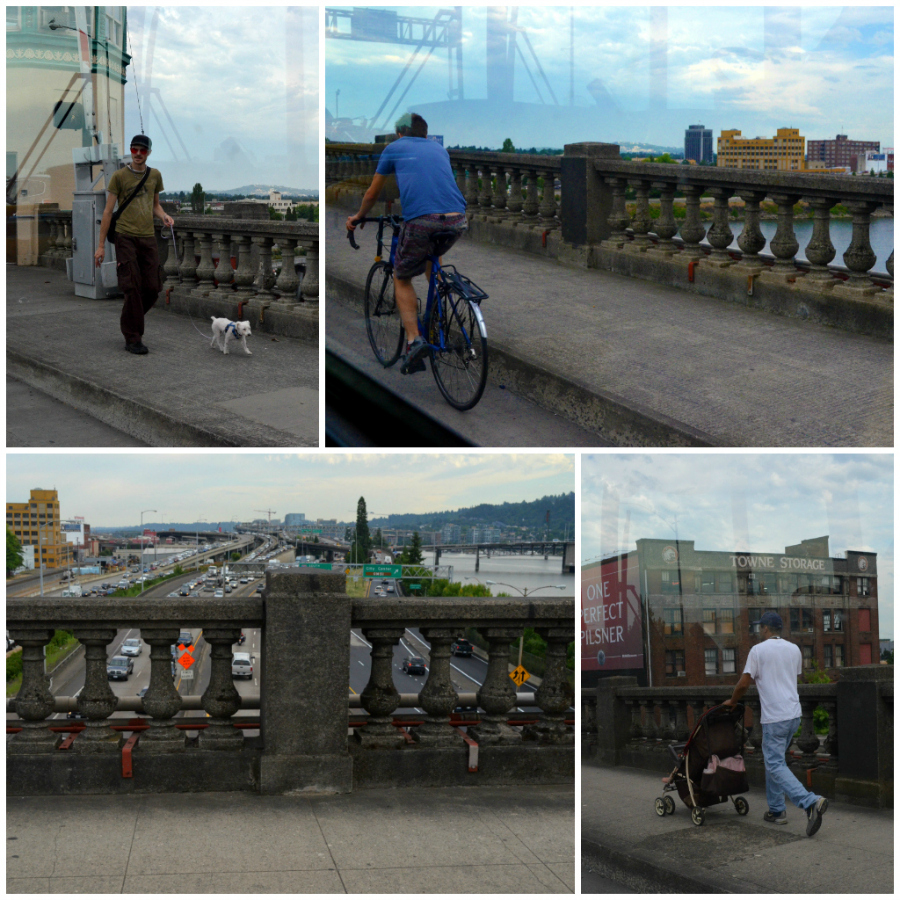
I decided to take one photo of someone we passed on the bus, which led to another photo, and naturally to others. Can't help myself, y'all. I love this city and what goes on here and there. We're heading east from downtown Portland on Burnside, the street that divides Portland into its north and south sections. And since the Burnside Bridge crosses the Willamette River, the east/west divider, at some point I must be in the exact center of the city. My photos: a man and his dog walk west with one of the Italian Renaissance towers reflected behind them; a man on his bicycle rides east; typical I-5 traffic, most of what you see is northbound; and a man with a child in a stroller, walking east.
About the Burnside Bridge, from the Multnomah County Web site:
One of four Willamette River crossings built in Portland during the "Roaring Twenties," the Burnside Bridge stands in age right behind the County's Hawthorne and Broadway bridges.
This 1926 structure is located on one of the longest and busiest streets in the Portland area. The five-lane Burnside is a direct connection between downtown Portland, Beaverton to the west and Gresham to the east. Last year, about 40,000 vehicles a day used it. So did more than 1,000 pedestrians and bicyclists each day.
In addition to its important daily work load, Burnside plays a key role during emergencies. Burnside Street and bridge are designated as an official emergency transportation route. The bridge, as part of this "lifeline corridor," is the one non-freeway river crossing which emergency vehicles and suppliers are asked to use.
Burnside's artistic side - The three-span Burnside is a historically significant structure. It is the only Willamette River bridge in Portland designed with the help of an architect, a result of the early 20th century City Beautiful Movement that called for adding architectural ornamentation to engineering designs. The bridge's distinctive Italian Renaissance towers reflect the trend. Burnside is eligible for the National Register of Historic Places and protected by preservation laws. Originally designed by the firm of Hedrick and Kremers, Burnside was completed by Gustav Lindenthal (1850-1935). Burnside's opening mechanism, or bascule, was designed by Joseph Strauss (1870-1938), whose Golden Gate suspension bridge would open 11 years after Burnside.
The Burnside Bridge main river structure consists of two 268-foot side span steel deck truss side spans and a 252-foot double-leaf Strauss trunnion bascule draw span. The bridge originally had six lanes of traffic, but in 1995 the City of Portland requested that bike lanes be added to the bridge, so one lane of traffic was converted into two bike lanes. There are sidewalks on both sides of the bridge. The overall width of the structure is 86 feet. Vertical clearance of the closed bascule span is adequate for the majority of river traffic, with openings necessary only about 40 times per month.
Only minor modifications have been made to the bridge since its construction. Electric street car rails were removed in the late 1940’s, lighting and traffic control devices were updated in the late 1950’s, automobile traffic gates were installed in 1971 and the bascule pier fenders were replaced in 1983. Several deck resurfacing projects and expansion joint repairs have also taken place.
The east approach to the bridge is approximately 849 feet long and has two distinct types of construction. The first eight spans consist of steel plate girder spans ranging from 75 feet to 106 feet in length. The steel girders and steel interior floor beams are completely encased in concrete. A concrete deck spans the floorbeams. The next seven spans are composed of concrete stringers spanning continuously over concrete columns and floorbeams. Six of these spans are 22 feet long and one is 40 feet long.
The west approach is approximately 604 feet long and consists of 19 reinforced concrete spans ranging in length from 22 feet to 62 feet. The first 13 spans average 22 feet and consist of reinforced concrete stringers acting continuously over concrete columns and floorbeams. The next three spans average 40 feet in length and are of similar construction. The last four spans are 62 feet long and consist of four main simple span concrete girders that carry interior concrete floor beams and stringers. A concrete deck is cast with the girders, stringers and floorbeams.
From Wikipedia: A bascule bridge (sometimes referred to as a drawbridge) is a moveable bridge with a counterweight that continuously balances the span, or "leaf," throughout the entire upward swing in providing clearance for boat traffic. Bascule is a French term for seesaw and balance, and bascule bridges operate along the same principle. They are the most common type of movable bridge in existence because they open quickly and require relatively little energy to operate. Bascule bridges may be single or double leaf. Both have any truss structure and counterweights below the deck.

4 comments:
You have provided so much information on your city today.
I can't say specifically why I like this so much. There's a relaxed spirit from the pedestrians in contrast to rush hour traffic in full of variety.
Great bus ride shots.
Oops I left out some words in editing. Meant to say "in a city" full of variety.
Post a Comment